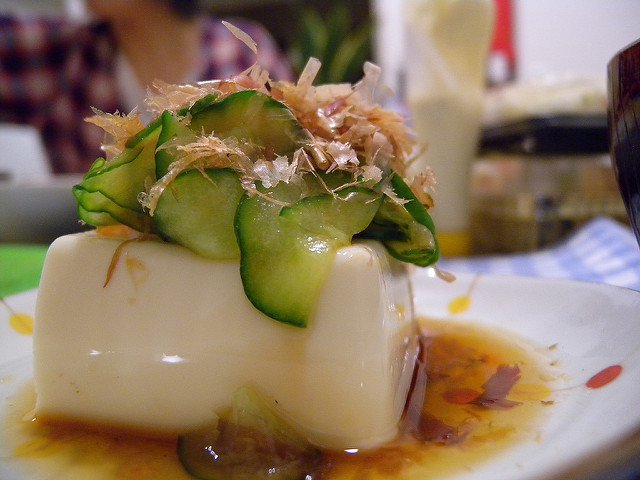
Tofu—not exactly a word you associate with “sexy, exciting food.” I mean, look at it. It’s white, square, and uninspiring. Like a big block of “blah.”
But that is just one of the many misconceptions about this often maligned, hastily judged humble food product. Most people I know think you can only fry tofu and toss it with pork. While tokwa’t baboy is the quintessential bar chow (now slowly making its way into American tummies), the lowly bean curd is more versatile than you think.
And although I rely on it for protein and calcium (being vegan), tofu is not definitively the be-all and end-all of healthy food. There have been conflicting reports about its impact to the body, especially for women. Will it cause cancer? Does it prevent the development or recurrence of cancer?
Here’s the thing: anything in excess will be bad for you. Tofu is not an exception. Here are key things you need to know about this plant-based food:
There is more than one type of tofu
You’ll see them in your slightly pricey grocery store, in Japanese or Chinese packaging. Tofu typically comes in silken (Japanese) or soft (Chinese) and firm (or regular) varieties. The silken or soft tofu has more water than firm tofu, making it creamier and more delicate. Because of its smooth texture, you can use silken tofu for soups (e.g., miso) or as an egg substitute to add moisture to vegan baked goods.
Firm tofu is spongy, and comes in medium to extra firm variety. The firm tofu, or tokwa, is what you’ll normally get from your local market. You can slice it, dice it, mash it, crumble it, shred it—you can do practically anything to this type of tofu. And cook it anyway you want: baked, grilled, barbecued, stewed, deep fried with batter, pan fried, and so on.
Tofu is processed food
This is why you’ll hear some vegans scoff at tofu; tofu is soybean milk from white soybeans that have been boiled, curdled, and pressed. A coagulant is added to the soybean milk, then simmered until the mixture curds and liquid separates. The liquid is then put into molds lined with cloth and pressed until the liquid squeezes out. The pressing time depends on whether the tofu is intended to be firm.
Tofu is unlike tempeh, which most vegans prefer. The fermented soybean is less processed than tofu. Per cup, tempeh has more protein and fiber. But unlike tofu, it isn’t as readily available. It’s an Indonesian specialty, so you only really get it at organic weekend markets or special groceries.
Eating soy is good for you
The National Center for Complementary and Integrative Health studied soy and found that it can, among other things, reduce bad cholesterol and the isoflavone (an estrogenic compound) can decrease the degree and severity of menopausal hot flashes. The American Heart Association Science Advisory also finds positive effects from soy:
- Soy isoflavones can reduce bone loss after menopause
- Soy isoflavones could reduce the risk of breast and endometrial cancers in Asian countries
Meanwhile, a study of 5,000 Chinese women, survivors of breast cancer, found that those who ate the most soy did better in four years after diagnosis and treatment.
Eating too much soy is bad for you
Overconsumption of soy, in this case, tofu, comes at a steep price. For a man in Eastern China, that price meant spending hours on the surgery table, getting 420 kidney stones removed. Doctors attributed it to the man’s excessive daily diet of gypsum tofu, which has calcium sulphate (a coagulant); calcium sulphate isn’t released from the body without enough water intake.
Then there are tofu products made from genetically modified organism (GMO) or genetically engineered (GE) soy; 90% of soy products in the US are GE. GMO or GE food can kill good bacteria in your gut, which can create a whole slew of health problems.
Scientific American also reports that animal studies indicate that overconsumption of soy might reduce fertility in women.
Tofu can help you lose the excess weight
Tofu is a complete protein, containing all nine essential amino acids (that our body can’t make on its own), which means you’ll feel full well enough to stop eating excessively.
Here’s the thing: a plant-based diet is better than a meat-based diet. It’s cheaper, if you don’t go to the pricey vegan places and you make an effort to cook your own meals. It’s healthier, so long as you don’t cook your food in heavy oil, salt, or consume overly processed (e.g., seitan, TVP) meat substitutes. And just consider how the world’s top 10 killer diseases are related to meat-based diets, from heart disease to diabetes.
While tofu isn’t entirely without its downside, it’s still a better option to meat. Just make sure you’re getting non-GMO, local tofu. Sauté, grill, or bake instead of frying all the time. Eat in moderation with fresh vegetables or mushroom varieties. When you get creative with tofu, it’s going to be more than just a big block of white “blah.”
